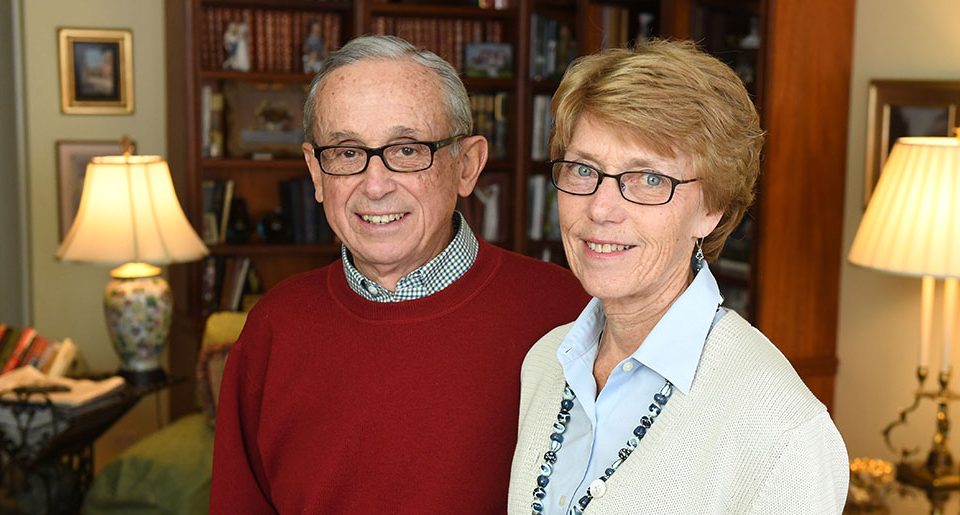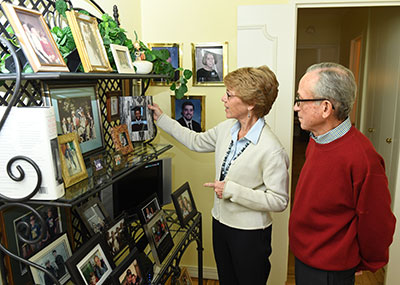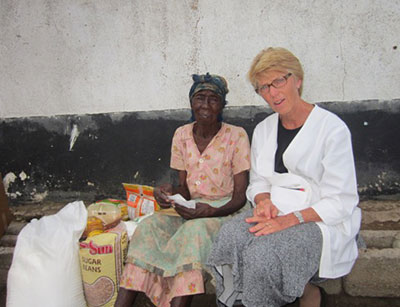What Do Heroes Look Like?

The Hartmanns: Home-Based Care in Swaziland
This article originally appeared in Fordham News, January 27th 2017.
Kathleen Hartmann rummaged through a green duffel bag on the floor of her Upper East Side living room, proud of how tightly she had packed its contents. In the sack were eight boxes’ worth of medically treated bandages.
“We put them in bags and just sucked all the air out so they would be flattened and we could get as many in there as possible,” said the longtime nurse.
The high-tech dressings, donated by a medical supply company, had proved very successful in treating the infected wounds of the patients she and her husband Al Hartmann, M.D., FCRH ’63, see on their homestead visits in Swaziland. It was December, and the couple was preparing to head back in January to the tiny southern African nation, where they spend six months of every year providing home-based medical and palliative care in poor, rural communities ravaged by AIDS, cancers, and other illnesses.
“Some of [the bandages]you can put on and leave for seven days,” which is very helpful for wound care out in the bush, Kathleen said.
Creative Solutions
It’s been 15 years since Kathleen first helped to establish the home-based health team in rural Swaziland, and she and Al have learned more than a few creative tricks and solutions. On their visits with the home-based care team from the Good Shepherd Mission Hospital, they see as many patients as they can in a 60-mile radius, administering medications and treating the symptoms of the sick and dying. But they also provide whatever they can that will make life easier on these families, with whom they’ve grown very close.
“You can’t really give somebody a pill or dress a wound without giving them nutrition and clean water and making sure their roof gets put back together,” Kathleen said.
In addition to the bandages, the Hartmanns planned to bring collapsible lanterns they found at a U.S. camping store. The simple tools provide light in huts where there’s no electricity. “They work so well,” Kathleen said. “People giving morphine in the middle of the night to a sick person with no light—how do you even do that?”
They’ve also learned to put markings on syringes for caregivers who can’t read, and to make charts where they could check off smiley faces or sad faces to record whether or not the dose was effective.
Over the years, the Hartmanns have held small fundraisers at a Manhattan bar to raise money for their work in Africa. That funding has paid for supplies, including food packs with cooking oil, beans, a type of corn meal, and peanuts for protein.
“There are so many things that factor into the health issues—from nutrition to housing to sanitation to water—that sort of get extended into what we do,” Al said.
Answering a Calling—with Support
Just before Kathleen’s first trip to Swaziland, the Hartmanns were living in Malone in upstate New York, where they had raised their three children. After the kids had finished college—two of them at Fordham—Kathleen, who had worked as a hospice nurse in Malone, felt a strong calling to help those suffering from AIDS in developing countries. She contacted the Catholic Medical Mission Board, and they connected her with the Good Shepherd Mission Hospital in Swaziland.
Al was medical director of a hospital and had started a cardiac rehab program so he couldn’t leave his job just yet. “I was the support group on this end,” he said—coordinating donations and other details.
Though she’d done outreach in poor communities in the U.S., Kathleen said nothing could have prepared her for what she saw when she arrived.
Facing a Pandemic
“In 2001, the pandemic of AIDS was taking over the hospital,” she said. “There were people lying everywhere. You could barely walk. They weren’t even in beds. They were on the floors and dying because there were no medications.”
A monarchy with a population of about 1.45 million, Swaziland has the world’s highest estimated prevalence rate of HIV-infected adults—27.4 percent of people aged 15 to 49, according to a 2013 estimate by the Centers for Disease Control and Prevention. And it was worse back in 2001, before antiretroviral drugs were available in the country.
“It was a death sentence,” Kathleen said.
To make matters worse, many of the sickest patients couldn’t even make it to the hospital because the journey was too long and treacherous. They were dying in their homes from this mysterious disease that was wiping out their young people and leaving children orphaned. Some Swazis thought it was a curse.
When she got to Swaziland, Kathleen met Anna Zwane—a nurse and former head matron of Good Shepherd who had been called out of retirement to address the crisis. She was charged with helping people go home to die, instead of dying alone in the hospital.
Kathleen calls her “the Mother Teresa of Swaziland.”
“I’ve never been closer to another human being except my husband. She’s an amazing woman, and she’s still helping us. We call her every week,” Kathleen said. Zwane founded the home-based care team, and Kathleen helped her organize and grow it. She went back a few times on her own, and Al began joining her in 2012.
“The work she started [with Anna]has become sustainable, which we consider sort of a big positive because not all outreach efforts are sustainable,” Al said.

The Hartmanns show off photos of the young Swazis they’ve worked with, alongside photos of their own children and grandchildren. (Photo by Chris Taggart)
Providing Palliative Care
An internist and a palliative care physician, Al had been providing home hospice care through Visiting Nurse Service since the Hartmanns moved to Manhattan in 2003. So he’d had a lot of experience doing the kind of work Kathleen and Anna had been doing in the field.
“They were doing in Swaziland what we were doing here, except they didn’t call it that,” Al said.
In 2012, with Al on board, the team started a formal palliative care program. They were finding that even though HIV patients were living longer because of the antiretrovirals, they began developing what the Hartmanns called “horrific cancers”—like cervical and uterine—that affected women in their 20s, 30s, and 40s. The only pain medication available to them was Tylenol, and it was hardly adequate. Through a lot of lobbying, Al was able to get a U.S. government program to provide morphine for these patients—a big component of the team’s palliative work. This program required a more intense level of care.
“You can’t see [palliative care patients]once every two months. You’ve got to see them as often as you need to see them, because they need such aggressive symptom management,” Al said. “So we dedicated one day a week just to do palliative care work. Now it’s gotten so big, we kind of put it on the other days when we’re in certain areas.”
“They Raise the Roof Singing”
Al said that spiritual care is a major part of caring for the sick and dying, noting that it’s impossible to do one well without the other.
“We’ll say, ‘Would you like us to pray with you before we leave?’ One hundred percent of the time, they want it.”
“Obviously, you don’t start with that,” Kathleen said. “We go in there, these people are suffering, they’re hungry, they’ve got terrible wounds, they’re in pain. … We’ll say, ‘Would you like us to pray with you before we leave?’ One hundred percent of the time, they want it. They sing, they start a beautiful hymn … and it’s usually thanking God, and my heart is saying, ‘Oh my gosh, if I was in this situation, would I be thanking God?’”
Al added: “They raise the roof singing. All of them are born with voices. It’s unbelievable. Some people are better than others. I’m OK. Kathleen is good. The Swazis are amazing.”
Cultural Learning Curve: The Cotton Ball Story
Working in another culture, particularly one steeped in abject poverty, presents a cultural learning curve. Case in point—an anecdote Kathleen calls “the cotton ball story.”
They had been tending to a woman with lung cancer and terrible wounds on her breast that she had been cleaning with cotton balls. So the team irrigated the wound and removed the cotton, and brought her caregiver some fresh bandages that wouldn’t stick to the wound. They left them there in a Ziploc bag.
“We went back a few weeks later. … I look and here’s this cotton ball stuck to the wound again. Same thing. I thought, obviously I didn’t teach her properly.” She asked the caregiver why she hadn’t used the nonstick bandages, and learned it was because they didn’t know how to open the bag.
“And they didn’t want to rip the bag because it wasn’t theirs,” she said. “So, talk about learning. That was a big learning moment for all of us. “
A Little Help from a Friend
Last summer, the Hartmanns had a little help in Swaziland from their son Al’s old Fordham roommate, Michael Davidson, FCRH ’94, managing director and head of real estate for the Americas at JPMorgan Chase. (The Hartmanns’ other son, Ken, is a 1995 Fordham College at Rose Hill graduate. They also have a daughter, Maureen. And Al’s father, Al Hartmann Sr., is a 1932 Fordham graduate.)
Davidson was looking to take a vacation, he said, “but not a vacation that was from luxury to luxury. I wanted to go to a place where I was going to be in touch with some real struggles that human beings are facing in this world.”
He spent two weeks going on homestead visits with the Hartmanns and their team, delivering supplies (including lollipops for the children), fixing gutters, and bearing witness to the suffering and poverty. But, Davidson said in a recent article he wrote about his experience, he never heard a complaint.
“I was charmed by the sense of grace and humility among people that have faced such challenges. How kind they were. So many people with so much often aren’t kind. That was to me the most startling aspect of the trip.”
On these visits, the Hartmanns were greeted like “a family member you love dearly,” said Davidson, a member of Fordham’s President’s Council. “They are so loved and trusted in a deep human way.”
Lasting Bonds
Over the years, the Hartmanns have developed close ties with many of the Swazis that they see year after year. Perhaps their closest bond is with Thobani Khuzini, whom Kathleen met in 2001 when he was 11. Thobani was born with spina bifida—a spinal condition that rendered his legs useless. The Hartmanns helped him get the medical help he needed, including a double amputation of his legs below the knee.
Kathleen calls Thobani her sixth grandchild, and she lights up when she says his name. He’s a strong man of 27 now, getting around handily in his wheelchair, working and supporting his mom and the many children that live in his homestead. He also helps the Hartmanns in their work with other families, including gardening. “Thobani gets right out of his wheelchair, gets in the ground and digs,” Kathleen said. She hopes to bring him to the U.S. next year for a visit.
The Hartmanns have also grown close with several of the “gogos”—an affectionate Swazi term for grandmothers.

Kathleen with Gogo Vilane, who cares for 12 grandchildren whose parents died of AIDS. The Hartmanns sometimes provide food packs for her.
“A whole generation of young people have been wiped out with HIV/AIDS. The children that they left behind are being cared for by their grandmothers,” Al said. “These people may be taking care of 10 to 15 children. With no financial backing. So I’ve often said, when TIME magazine is looking for someone for their Person of the Year, they should think of these African grandmothers. Because they are the cement and the glue that keep it together.”
Another couple that the Hartmanns have grown close to is Kapteni and his wife, whom they call Gogo Kapteni. “They were living in a tiny little house made out of just pieces of corrugated iron that they had found around. So we took care of them medically. … Then, as time went on, we helped build a house for them,” Kathleen said.
The couple “love each other desperately,” she said. When she was hospitalized with a tumor, he walked miles every day to be by her side.
Kapteni and his wife had no place to cook in their modest home, so some of the young men that Al and Kathleen had helped over the years helped to build a kitchen for them. “They go back regularly to fix it for them. They’ll go back to help them plant their maize. So these young Swazi men, through working with the home-based care team, and [other organizations], have learned outreach. So, they’ve been helped, and now they’re helping their own people.”
Photos from Swaziland courtesy of the Hartmanns and Michael Davidson.

